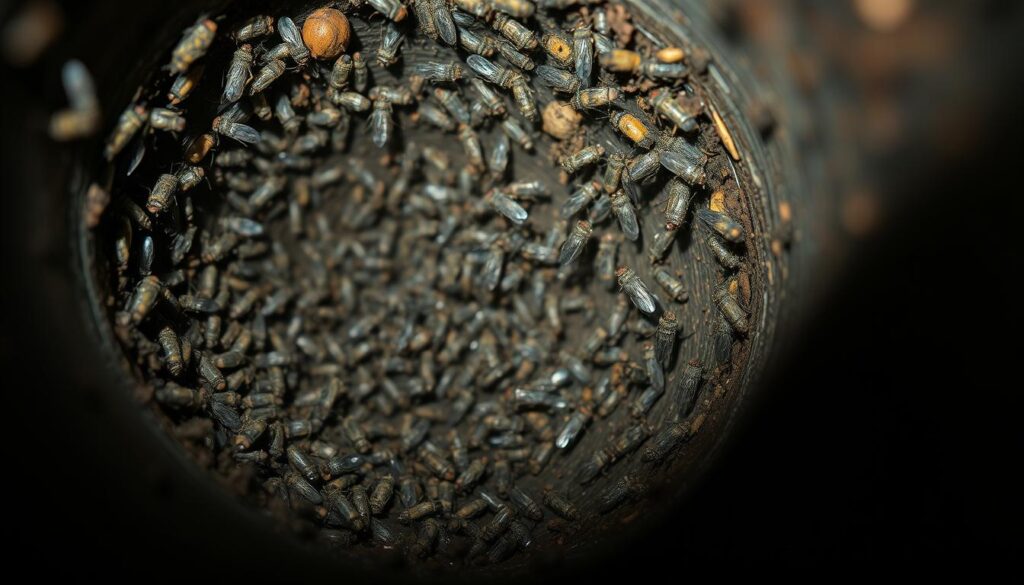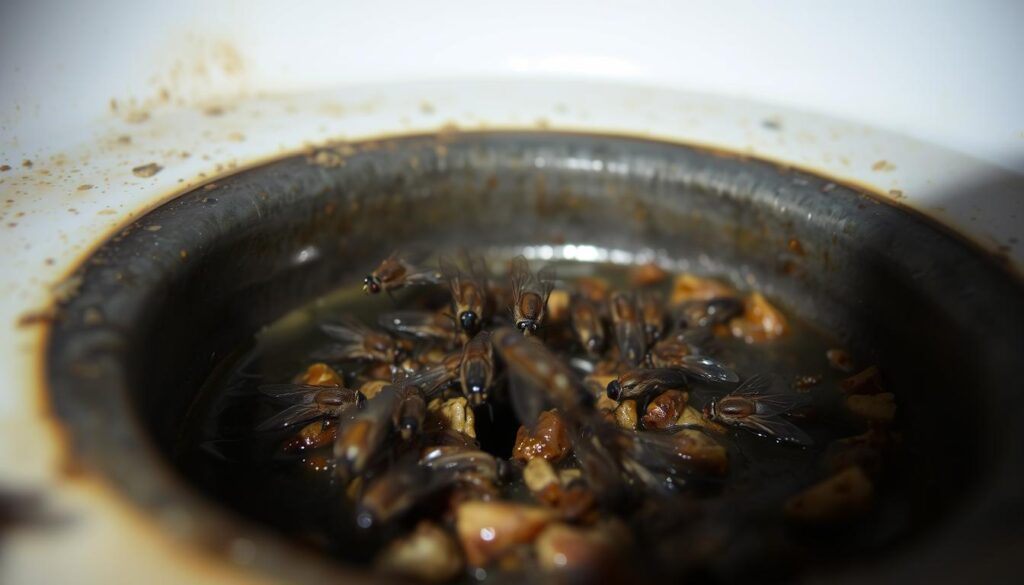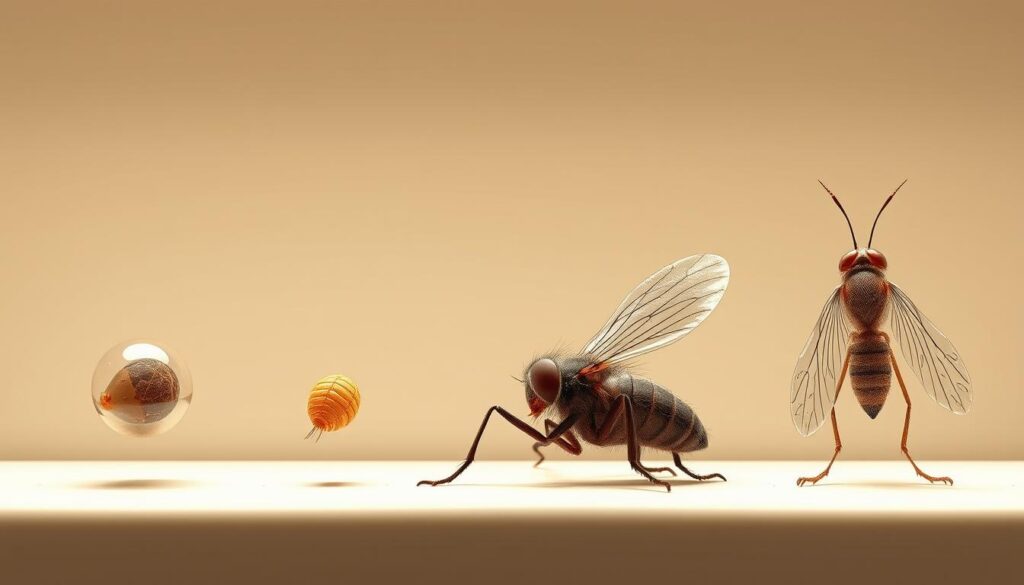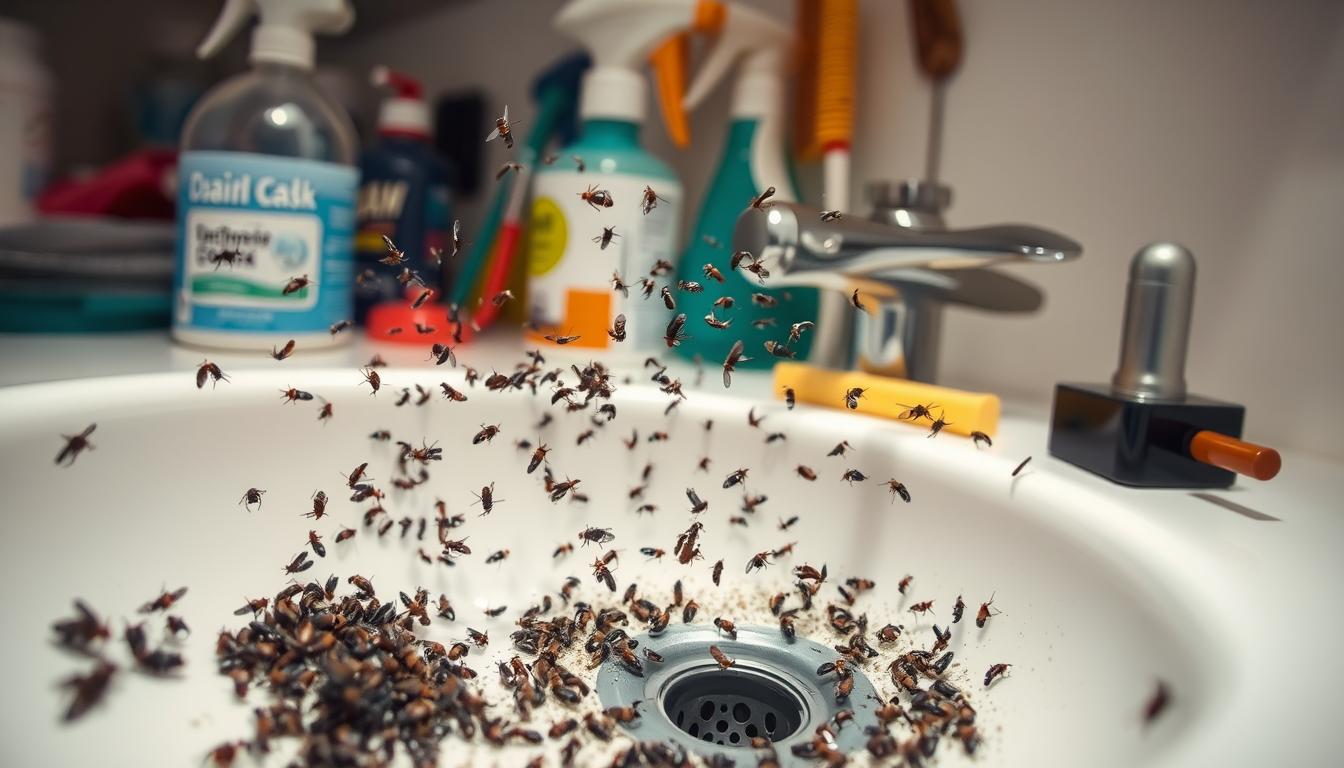How to Get Rid of Drain Flies in Your Home
Ever walked into your kitchen or bathroom and seen tiny, moth-like bugs around your drains? Those are drain flies, also known as moth flies or sewer flies. They can quickly make your home a frustrating place.
Drain flies love moist places, especially in pipes and drains where organic matter builds up. They might look harmless, but they can grow fast. This can make your home uncomfortable and possibly unclean.
Knowing how to spot, get rid of, and stop drain fly infestations is key to a clean, healthy home. This guide will show you all you need to know about dealing with these pesky pests.
Table of Contents
Understanding Drain Flies: Identification and Characteristics
Drain flies, also known as sewage flies, are tiny pests that can sneak into your home. They thrive in moist areas. Knowing how to spot them can help you keep them away.
These pests are very small, only 1/8 of an inch long. Their unique look makes them easy to spot.
Physical Appearance and Unique Features
Drain flies have some key features:
- Brown-gray or black fuzzy body
- Hairy wings shaped like leaves
- Wing position resembles a protective roof when at rest
Species and Classification
The Psychodida family includes many drain fly species, such as:
- Sink flies
- Filter flies
- Sewer gnats
The most common one, Clogmia albipunctata, is often found in homes.
Flight Patterns and Behavior
Drain flies have special ways of moving:
- Short, hopping flight patterns
- Tendency to rest on walls and ceilings
- Most active during low household activity periods
| Characteristic | Details |
|---|---|
| Average Size | 1/8 inch long |
| Egg Production | 15-40 eggs per female |
| Life Cycle | 21-27 days |
| Adult Lifespan | Up to 7 days |
Spotting these pests early can stop them from breeding and spreading in your home.
Why Drain Flies Invade Your Home

Drain flies, also known as sink flies or bathroom flies, can quickly turn your home into their breeding ground. These tiny pests are master opportunists, seeking out specific conditions that make your living spaces attractive to them.
Understanding why drain gnats invade your home involves examining their preferred environments. These insects are drawn to moist, organic-rich areas where they can reproduce rapidly. Key locations include:
- Kitchen sink drains
- Bathroom plumbing
- Rarely used floor drains
- Leaky pipes
- Stagnant water collections
Drain flies thrive in environments with standing water and organic debris. Their life cycle is remarkably quick – females can lay up to 200 eggs in a single batch, which hatch within 48 hours. This rapid reproduction means a small problem can escalate quickly if left unchecked.
“Prevention is always better than cure when it comes to drain fly infestations.” – Pest Control Expert
Your home becomes an ideal breeding ground when certain conditions are present. Neglected drains, moisture buildup, and accumulated organic matter create perfect habitats for these persistent bathroom flies. Addressing these conditions is crucial in preventing and controlling their population.
Drain flies typically enter homes through:
- Open windows and doors
- Cracks in foundation
- Unsealed pipe connections
- Ventilation systems
By understanding these invasion routes and breeding preferences, you can take proactive steps to make your home less appealing to drain gnats.
Common Areas Where Drain Flies Breed
Drain flies, also known as drain midges, can turn harmless spots in your home into breeding grounds. Knowing where they breed is key to controlling pests and stopping infestations. This is important to avoid health risks from drain flies.

Indoor Breeding Hotspots
Your home has many hidden spots where drain flies can breed. They like moist places with organic matter. Some common indoor spots include:
- Kitchen sink drains
- Bathroom shower and sink drains
- Rarely used toilets
- Floor drains
- Condensate pans under refrigerators
- Dirty trash cans
Outdoor Breeding Sources
Drain midges also breed outside. Outdoor areas can support their growth just like indoor ones:
- Clogged rain gutters
- Birdbaths with stagnant water
- Moist compost piles
- Septic tank surroundings
- Rain barrels
Hidden Areas to Investigate
Some breeding spots are less obvious but still a problem. Look in these often-missed places:
- Air conditioner drip pans
- Basement sump pumps
- Potted plant saucers
- Toilet tank interiors
- Refrigerator and freezer drainage systems
By checking these areas, you can stop drain fly breeding. This helps reduce health risks from their presence.
The Life Cycle of Drain Flies
Understanding the life cycle of drain flies is key to getting rid of them in your home. These small insects go through four main stages. Each stage is important for their growth and survival.

The life cycle starts when female drain flies lay eggs in moist, organic-rich spots. These insects are very prolific. Females can lay up to 300 eggs in just two weeks.
Stages of Drain Fly Development
- Egg Stage: Females lay 10 to 200 eggs in clusters, usually in damp areas like drains and organic debris
- Larval Stage: Drain fly larvae develop over 9 to 15 days, feeding on microorganisms in moist environments
- Pupal Stage: Transformation occurs in wet, nutrient-rich locations
- Adult Stage: Mature drain flies measure 2 to 5 mm in length
Temperature greatly affects how fast drain fly larvae develop. In warmer conditions, their life cycle can be completed in as little as 8 days. But cooler environments may extend the process to 24 days.
“Knowing the drain fly life cycle is the first step in effective pest control” – Pest Management Professionals
To effectively kill sewer flies, target each stage of their life cycle. Keep your home clean and dry. Also, address any moisture sources.
Health Risks and Concerns Associated with Drain Flies
Drain flies might seem like a small problem, but they can cause health issues. They don’t bite or sting, but their presence can lead to health concerns. Homeowners should know about these risks.
Potential Health Hazards
Drain flies are not direct disease carriers, but they can still pose health risks. These tiny flies carry potential complications:
- Trigger allergic reactions from decaying insect bodies
- Exacerbate respiratory conditions like asthma
- Mechanically transfer bacteria from unsanitary areas
Impact on Indoor Air Quality
Drain fly infestations can harm your home’s air quality. Their tiny body parts become airborne, causing respiratory irritation. People with sensitivities might find it harder to breathe when these flies are around.
Food Safety Concerns
The biggest risk is food contamination. Drain flies move between dirty places and clean surfaces, spreading germs. They can carry bacteria from drains to kitchen counters and food areas, posing a hygiene risk.
Professional pest management experts recommend prompt intervention when drain fly populations become noticeable.
Regular cleaning, keeping areas dry, and fixing moisture issues can help reduce health risks from drain fly infestations.
How to Detect a Drain Fly Infestation
Spotting a drain fly infestation early can prevent big pest problems. These tiny flies love damp places, making it important to find them quickly. Look for small moth-like insects on bathroom or kitchen walls. They are clear signs of drain pests.
- Sticky Tape Test: Cover drain openings with clear tape overnight
- Vegetable Oil Trap: Place a cup with oil over suspected breeding areas
- Flashlight Inspection: Check drain openings for characteristic slimy buildup
The vegetable oil trap is very effective. Put a small cup with oil over a suspected drain opening. Any flies that come out will get trapped, showing where they breed. Adult drain flies are about 1/8 inch long and like shaded spots during the day.
| Detection Method | Effectiveness | Difficulty |
|---|---|---|
| Sticky Tape Test | High | Easy |
| Vegetable Oil Trap | Very High | Simple |
| Flashlight Inspection | Medium | Moderate |
If you see many drain flies or find breeding sites often, you might need a pro. Remember, catching them early is crucial to stop big drain pest problems.
Natural Methods to Eliminate Drain Flies
Dealing with drain flies doesn’t need harsh chemicals. Natural solutions can get rid of these pesky flies safely and effectively. Let’s look at some eco-friendly ways to fight drain gnat infestations using common household items.
Vinegar and Baking Soda Solution
A simple mix of baking soda and vinegar is a powerful natural treatment. Here’s how to use it:
- Pour 1/2 cup of baking soda down the drain
- Follow with 1 cup of white vinegar
- Plug the drain and let the mixture sit for 1-2 hours
- Flush with hot water
This method works by reacting chemically to break down organic matter where drain flies breed. Do this daily for a week to get the best results.
Boiling Water Treatment
Boiling water is a simple way to kill drain fly larvae and clean the drain. Here’s how to do it:
- Boil a large pot of water
- Pour water slowly and carefully down the drain
- Repeat the process 2-3 times
- Use a drain brush to scrub interior surfaces
Enzyme-Based Cleaners
Enzyme-based cleaners are a great alternative for a deep clean. These products break down organic matter in drains, targeting where drain gnats breed.
| Cleaner Type | Effectiveness | Average Cost |
|---|---|---|
| Commercial Enzyme Gel | High | $33 per 128 fl oz |
| Homemade Enzyme Solution | Moderate | $5-10 for ingredients |
Remember, regular maintenance is crucial to stop drain fly infestations. Flush your drains weekly with hot water and do a deep clean monthly to keep these flies away.
Chemical Solutions for Drain Fly Control
Chemical solutions are a good way to fight drain midge infestations. Knowing which treatments work best helps control drain fly numbers in your home.
Effective chemical solutions for drain fly control include:
- Insecticide sprays designed for flying insects
- Peracetic acid treatments (4000 ppm concentration)
- Specialized drain cleaners
- Insect Growth Regulators (IGRs)
Are drain flies harmful? They don’t bite humans, but they can spread bacteria. Chemical treatments can stop their breeding and lower health risks.
| Chemical Treatment | Effectiveness | Application Method |
|---|---|---|
| Aerosol Insecticides | High | Spray directly on flying insects |
| Peracetic Acid | Very High | Pour into drain pipes |
| Enzyme Drain Cleaners | Moderate | Overnight treatment |
Always follow the instructions when using chemical solutions. Wear gloves and masks for safety. Be careful to avoid damaging your plumbing system.
Chemical treatments are more effective with good cleaning and removing breeding spots. If the problem persists, you might need to try different methods.
Preventing Future Drain Fly Infestations
To keep sewer flies away, you need a solid plan for home care. Cleaning drains and controlling moisture are key. This stops drain fly larvae from growing. Make your home a place where these pests can’t thrive by tackling their breeding spots.
Start a monthly routine to keep drains flowing. Use drain strainers to catch debris. Also, check places with lots of moisture like bathrooms and kitchens for water buildup. Use green cleaners to break down organic matter that draws drain flies. Make sure your home is well-ventilated to lower humidity and stop their growth.
Don’t forget about outdoor areas where drain flies might breed. Keep compost piles clean, remove standing water near trash, and seal entry points. By managing moisture and organic waste, you can make your home less appealing to drain flies.
If drain flies keep coming back, it’s time to call a pest control expert. They can find and treat breeding sites and help you keep your home drain fly-free. Remember, stopping them before they start is always better than trying to get rid of them later.
FAQ
What are drain flies, and why are they in my home?
Are drain flies harmful to my health?
How can I identify a drain fly infestation?
What is the life cycle of a drain fly?
What are the best natural methods to eliminate drain flies?
Where do drain flies typically breed in homes?
Can I completely prevent drain fly infestations?
Are chemical treatments necessary for drain fly control?
How long does it take to get rid of drain flies?
Do drain flies indicate a more serious plumbing problem?
Source Links
- How to Get Rid of Drain Flies – https://www.stateindustrial.com/article/how-to-get-rid-of-drain-flies
- How to Get Rid of Drain Flies and Keep Your Sinks Sparkling – https://www.bhg.com/how-to-get-rid-of-drain-flies-8347426
- What Are Drain Flies? 7 Ways to Get Rid of Them | Pest Czar – https://pestczar.com/what-are-drain-flies-7-ways-to-get-rid-of-them/
- Drain Flies: What to Know – https://www.webmd.com/a-to-z-guides/drain-flies-what-to-know
- How to Identify and Get Rid of Drain Flies at Home – https://www.thespruce.com/getting-rid-of-drain-flies-2656670
- Invade Bio Drain – https://diypestcontrol.com/drainflies.htm?srsltid=AfmBOoorwyP1kY7stNdGylOcydZ4ggYlaDicpPewXV-Nk7J4Il0Ry93n
- How to Get Rid of Drain Flies: 6 Expert Tips – Truly Blog – https://trulynolenindia.com/blog/en/how-to-get-rid-of-drain-flies
- What Bug Experts Want You to Know About Getting Rid of Drain – https://www.prevention.com/life/a61536393/how-to-get-rid-of-drain-flies/
- How to Get Rid of Drain Flies | Jon Wayne – https://jonwayne.com/articles/how-to-get-rid-drain-flies
- Invade Bio Drain – https://diypestcontrol.com/drainflies.htm?srsltid=AfmBOopBBEj1GQQ3oYH53NYA6mdua95tlvr4rOBywvkyrbUhGy5j2JzZ
- AAA Pest Control – https://www.tripleapestcontrol.com/blog/2024/april/are-drain-flies-harmful-/
- Small Fly Solutions – Rose Pest Solutions – https://www.rosepestcontrol.com/blog/small-fly-solutions/
- Are Drain Flies Harmful? | The Plumbing Joint – https://www.plumbingjoint.com/blog/2024/august/are-drain-flies-harmful/
- The Hidden Menace of Drain Flies and How to Combat Them – Maryland Sewer and Plumbing Service, Inc. – https://www.mdsewer.com/plumbing/drain-flies
- Drain Fly Control & Treatment Services | My Pest Pros – https://mypestpros.com/pest-guide-drain-flies/
- How To Get Rid Of Drain Flies • Pest-Tech – https://pest-tech.org/how-to-get-rid-of-drain-flies/
- Invade Bio Drain – https://diypestcontrol.com/drainflies.htm?srsltid=AfmBOorE6wtDsqi7ykUFFig92hXVQ2GWosdszND7nirYmIb9BRCvxdx3
- How to get rid of drain flies — follow these 7 steps – https://www.tomsguide.com/home/how-to-get-rid-of-drain-flies
- How To Get Rid of Small Flies In Your Bathroom – https://www.familyhandyman.com/article/how-to-get-rid-of-drain-flies/?srsltid=AfmBOopo8Nub1afzkW2BCDuVnp7IcMxnyUXeOy8VItRCBcJ3t5j8k8Wn
- How to Get Rid of Drain Flies in Your Home | The Pest Dude – https://pestdude.com/how-to-get-rid-of-drain-flies/
- Invade Bio Drain – https://diypestcontrol.com/drainflies.htm?srsltid=AfmBOoqjiJOShWQ52FgbWVE2682cNRolhVJ4ZyrlYIHxuMu87XUhHwgz
- How to Get Rid of Drain Flies and Gnats – https://www.billhowe.com/blog/how-to-get-rid-of-drain-flies-and-gnats/
- How to Get Rid of Drain Flies – Jonny’s Drains – https://www.jonnys-drains.co.uk/how-to-get-rid-of-drain-flies/
- Steps to Prevent Drain Fly Infestations – Avalon Services – https://www.avalon-services.com.sg/steps-to-prevent-drain-fly-infestations/
- How to Get Rid of Drain Flies in 2025, Canada – https://www.luminalife.ca/blog/how-to-get-rid-of-drain-flies-in-2025
- Solve Drain Flies Issues with Our Tips in Southwest Florida | Certified Pest Control – https://certifiedpest.com/drain-flies/

